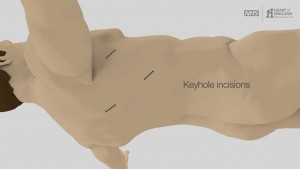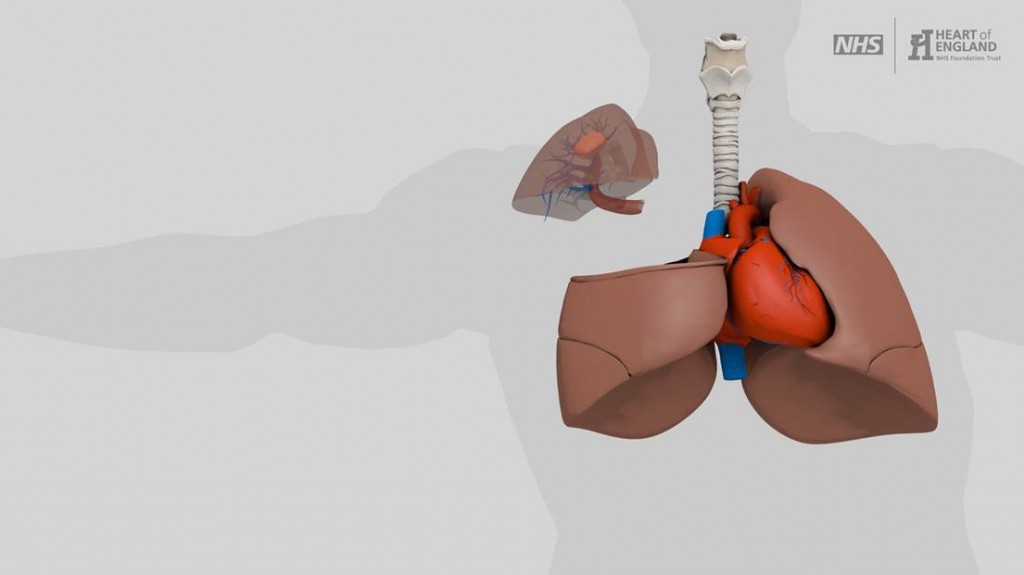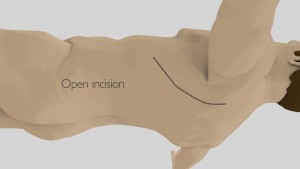What is a lobectomy?
In lobectomy either one third or one half of a lung is removed, along with lymph glands around it. This is done with you asleep and can be done keyhole (VATS) or open (thoracotomy). Surgery usually takes between 1 and 3 hours.
- Keyhole surgery (VATS)
 Up to 4 small cuts are made, each about 5cm (2 in) long. These are used for the instruments and small camera to go into the chest. The piece of lung is removed through one of the small cuts. The muscles and skin are closed with dissolvable stitches.
Up to 4 small cuts are made, each about 5cm (2 in) long. These are used for the instruments and small camera to go into the chest. The piece of lung is removed through one of the small cuts. The muscles and skin are closed with dissolvable stitches.
Research tells us keyhole surgery may have benefits over open surgery in cases where it is possible. These include: less pain, quicker recovery, shorter stay in hospital, smaller scars, quicker return to normal activities.
If a part of the operation cannot be done keyhole the operation may need to be changed to the open technique (thoracotomy). This may also be done if there is bleeding during surgery so the surgeon can stop the bleeding.
- Open surgery (thoracotomy)
Open surgery is done with one longer cut under the shoulder blade between 2 ribs. The 2 ribs are parted to get into the chest. One rib may be cut to give more space, ribs are not removed. At the end of surgery the 2 ribs are held back together with strong stitches. The muscles and skin are also stitched back together.
During surgery you lie on your side with your arm raised. The blood vessels and bronchus leading to the lobe to be removed are identified. Special staples are used to cut and seal the blood vessels and bronchus. If the operation is being done to treat lung cancer lymph glands will also be removed. 1 or 2 chest drains are put in at the end of the operation and held in placed with a stitch. These remove any fluid or air from around the lung.
See also Changes to surgery
See sections on:
Pain control Exercise and physiotherapyIn addition the following are risks of lobectomy:
- Minor more common risks
Air leaking from the lung into the chest drain for a few days is common after lung surgery. Occasionally this lasts for longer, possibly weeks. A chest drain will need to be in place until this settles, you may be able to go home with the chest drain still in and come back for regular check-ups until the air leak settles.
Your kidneys may not work as well after surgery but this is usually temporary and gets better with extra fluid.
- Major less common risks
Some people are more short of breath after surgery. Part of your preop assessment is assessing your risk of being breathless after surgery. If you already have lung disease there is a higher risk of being breathless, including needing to have oxygen at home.
Shortness of breath may severe enough to require help from a ventilator machine. This can be with a face mask with you fully awake. It may also be need via a tube in your windpipe with you under sedation. If you need help breathing via a tube for a long time it may be better to have a temporary tracheostomy. This is a tube put in through the neck which is removed once breathing improves.
A hole may form near the staples (bronchopleural fistula), this is usually only happens with an infection. It causes air to keep coming out of the lung but can be difficult to diagnose. You may need antibiotics and another operation to fix the hole.
Fatty fluid may collect in the chest (chyle leak), it is rare. You may require a temporary change in diet, a chest drain or another operation to treat this.
Nationally 98 in 100 people are alive 1 month after surgery and 2 people die. Your individual risk may be higher or lower depending on your health.
Surgery gives the best chance of being free from cancer if you have early stage lung cancer. You can discuss treatment options with your hospital doctors, your Lung Cancer Nurse and your GP. If you do not want surgery or are not well enough to have an operation other options may include:
- Radiotherapy
- Chemotherapy
- Radiofrequency ablation
- Palliative care
It is your choice whether to go ahead with surgery or choose another kind of treatment. We will respect your wishes and support you in choosing the treatment that suits you. You are always welcome to seek a second opinion.
Lobectomy may be done for long term lung infections; in this case the alternative would be to continue medications to control the infection.
Lobectomy may be done as emergency, this is lifesaving to control bleeding.



